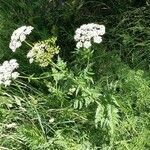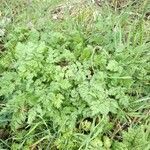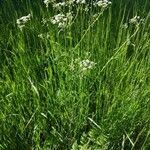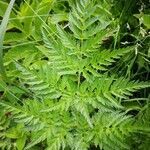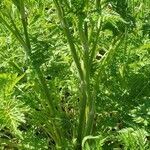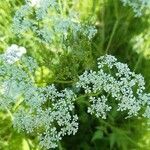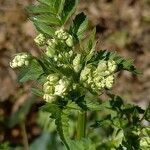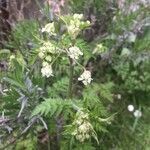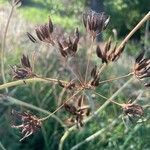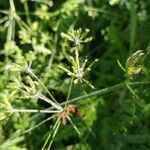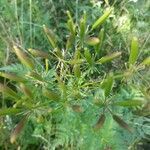Plants 0.6–1.5 m high. Stem stout, glabrous or lower parts finely pubescent. Basal leaves long-petiolate; petioles 10–30 cm, sheaths ca. 4 × 1 cm; blade ovate in outline, 10–30 cm; primary pinnae long-petiolulate, ovate to elliptic-ovate, 4–12 × 2–8 cm; ultimate segments ovate or elliptic-ovate, 1–3 × 0.5–1.5 cm, serrate or toothed, abaxially sparsely pubescent. Upper cauline leaves subsessile. Umbels 2.5–8 cm wide; rays 4–15, unequal; bracteoles 5–8, ovate to lanceolate, acuminate, shorter than pedicels, pedicel apex usually surrounded by white bristles in fruit. Styles ca. 2 × as long as stylopodium. Fruit 5–10 × 1–1.5 mm. Fl. and fr. Apr–May.
Perennial herb, 0.6-1.8 m high. Leaves bipinnate, tripinnate or sometimes 4-pinnate, fern-like; segments lanceolate to acuminate, toothed, glabrous or somewhat hairy. Flowers in sparse, terminal, compound umbels; involucre small or usually absent. Rays ± 8. Calyx absent. Petals notched, white. Flowering time Nov.-Feb. Fruit narrowly oblong, slightly 3-angled dorsally, glabrous and shiny at maturity. Seeds semi-terete and grooved on face.
A small plant. It grows 60-150 cm high. It spreads 40-60 cm wide. It forms clumps. The leaves are fine and feather like. They are divided 3 times. The leaves are 15-30 cm long. They are deep green. The flowers are white. Caution: Don't mistake this plant for the poisonous hemlock Conium maculatum.
Freely branched biennial or short-lived perennial to 1 m; lf-segments 1.5–5 cm; umbels large, with 6–15 rays to 4 cm; bractlets lance-ovate, 3–6 mm; fr glabrous, lanceolate, 6 mm, the beak 1 mm; 2n=16. Native of Europe, occasionally found as a weed in our range. May–July.
